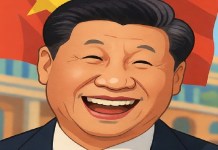Australia, a close ally of the United States that has been arming itself against potential security threats from China, is purportedly supplying Beijing with a critical mineral necessary for its hypersonic and nuclear program.
Chinese companies are the majority shareholders in two Australian mines producing zirconium, a little-known, vital mineral used in hypersonic missiles and nuclear sponges. This allows China to bypass “severe challenges” to accessing these resources, according to ABC News.
It states that Australian regulators not only allowed Beijing-backed firms to acquire significant stakes in the two mines in Western Australia, but also provided a $160 million soft loan to one of these companies to facilitate production. Australia is the world’s largest producer of the mineral and accounts for about 41% of China’s imports.
In addition to its use in toilets and bathroom tiles, zirconium sponge—a high-end product—is also used to wrap nuclear fuel rods. This could indirectly make this element a very crucial component in the unfolding rivalry between China and the US-Australia camp. According to the report, experts have noted that a country seeking to expand its nuclear arsenal would need a steady supply of Zirconium.
As reported by the EurAsian Times on multiple occasions, China has been rapidly expanding its nuclear program. China now has at least 600 nuclear warheads, with around 100 added to the stockpile each year since 2023, according to the latest Stockholm International Peace Research Institute (SIPRI) report published in June 2025.
Three Big Lessons From Mamdani’s Victory In New York, A City Dominated By Jewish American Community
This rapid expansion has been flagged by the US Pentagon and is seen as a security threat by the United States and its allies, who remain at loggerheads with Beijing.
Zirconium is considered ideal for the high temperatures endured by hypersonic missiles because of its high melting point, above 1,800 degrees Celsius.

China has a variety of hypersonic missiles in its inventory, some of which were unveiled during the Victory Day Parade in September 2025. These missiles are considered a threat by the US and its allies, including Australia, due to their high speed (five times the speed of sound) and unpredictable trajectories.
China is believed to have fewer than 1% of the world’s zirconium, a vulnerability that the People’s Liberation Army’s research and development arm, the National University of Defense Technology, has recognized and published in a paper.
The paper stated that “against the backdrop of intensifying global competition for strategic resources,” China’s allocation and utilization of zirconium has become a crucial matter for maintaining national security and promoting military technical advancement.
“A major importer and consumer of zirconium … China is facing severe challenges to resource security,” it stated, acknowledging its import of the mineral.
Interestingly, the Chinese admission comes just weeks after Australia signed a deal with the US to boost supplies of rare earths and other critical minerals to counter China’s dominance in that market.
The agreement would fund an $8.5 billion pipeline of “ready-to-go” projects to increase his country’s mining and processing capacity. A total of $1 billion will be invested in the projects over the next six months.
Strangely, this means that Australia is actively working to end China’s monopoly over the processing of rare earths and critical minerals, while simultaneously handing over the minerals needed for China’s military build-up.
Additionally, it may also be indirectly aiding Russia’s war against Ukraine, since this processed Zirconium is allegedly re-exported to Russia, as per data from Four Corners. Zirconium exports from China to Russia have increased by more than 300% since Russia invaded Ukraine in 2022.
This is in direct contrast to Australia’s condemnation of the Russian invasion and the supply of military aid to Ukraine.
The Curious Case Of Zirconium
While Australia has the world’s largest mineral sand reserves, from which zirconium is extracted, downstream processing is dominated by China.
China has sought to address its zirconium shortages through significant investments in two West Australian miners, including the ASX-listed Image Resources.
China’s LB Group, which has close ties to the Chinese government, is Image Resources’ largest shareholder. Moreover, the LB Group is Image Resources’ primary customer through a subsidiary, and China receives 100% of its products.
The other significant supplier of zirconium to China is Thunderbird Mine. The Foreign Investment Review Board (FIRB) authorized Yansteel, a Chinese corporation, to acquire a 50% stake in the Thunderbird mine in 2020.
The mine, which also sells 100% of its production to China, received a $160 million concessional loan from the Northern Australia Infrastructure Facility (NAIF) in 2022. This loan was the key driver in getting the mine into production, the ABC report stated.
It is difficult to predict what a material like this will be used for when it is transported into China. For one, China has a long history of using its civilian industry for military objectives, and suspicions over zirconium’s use for military purposes are inevitable.
While this does not imply that the Australian government is deliberately aiding China, Canberra may need tighter controls over its critical minerals and a check on who they are supplied to and for what purpose.
“I think it’s really important for us to have an understanding of where our minerals go … it’s appropriate to be applying those [controls] to things that might be used for nuclear or missile production,” said David Kilcullen, a military strategist and former adviser to the US secretary of state.
This could be done by creating a mechanism for end-use monitoring of dual-use minerals, which would likely require export licensing for zirconium sponge, and diversifying buyers to reduce the share of the material that goes to China.
Having said that, this is not the only bizarre association between China and Australia. Chinese private firm Landbridge won the bid for a 99-year lease of Darwin Port in Australia’s strategically vital Northern Territory in 2015.
This has been a subject of scrutiny in Australia for years, especially because the region is home to several key military bases, ammunition, and fuel storage facilities, as well as American troops.
The Complex Ties Between Australia & China
Australia has a complex relationship with China, characterised by a unique mix of trade cooperation and military tensions. China is Australia’s biggest trading partner, and is also seen by Canberra as the biggest threat to its security and regional influence due to its expansionist tendencies.
Australia is the closest US ally in the South Pacific and is expected to be a party in a potential US-China conflict. In fact, their mutual contempt for China has brought Australia closer to the US and strengthened defence cooperation between the two.
While the Australian leadership has never explicitly stated that it would aid Washington against China, the two allies’ robust military ties continue to expand, and their areas of cooperation continue to grow.
For instance, US President Donald Trump cleared all speculation about the AUKUS submarine deal, saying it was “full steam ahead” just last month. In addition, the US is exporting a host of cutting-edge weapon systems to Australia to aid its military modernization, as previously noted by the EurAsian Times.
Despite being trade partners, Australia and China remain marred by tensions. For one, China has been steadily advancing into the Southern Pacific Ocean and forging new security ties with Pacific Island Countries (PICs), a region that has long been an Australian bastion. Australia sees this as a major threat to its regional influence.

In addition, Australian officials and the 2023 Defense Strategy Review have flagged China’s aggressive tactics, including the coercive handling of territorial disputes and the risky interception of ships and aircraft operating in international waters and airspace over the South China Sea. In fact, Australia is also bolstering ties with China’s regional adversaries, including the Philippines.
The two sides often spar over dangerous interceptions of Australian aircraft conducted by Chinese fighter jets in international airspace over the South China Sea. One such incident occurred last month, as reported by the EurAsian Times at the time.
Australia has sought to reset its relationship with China in recent times, as evidenced by Australian Prime Minister Anthony Albanese’s visit to China earlier this year. “Dialogue with China matters. For jobs, our economy, and the security of our region,” he said at the time.
However, Canberra has continued to strengthen its association with the US. After the US imposed unprecedented tariffs on China earlier this year, China’s Ambassador Xiao Qian invited Australia to “join hands” with Beijing in “solidarity.”
Careful not to antagonise US President Donald Trump, the Australian Defense Minister Richard Marles duly rejected the offer.
“I don’t think we’ll be holding China’s hand,” Marles said, responding to the Chinese offer. “We obviously don’t want to see a trade war between China and the US … [but] it’s about pursuing Australia’s national interests, not about making common calls with China,” he was quoted as saying at the time.
Therefore, demonstrating that Canberra’s loyalties do not lie with Beijing.
- Contact the author at sakshi.tiwari13 (at) outlook.com
- Follow EurAsian Times on Google News




